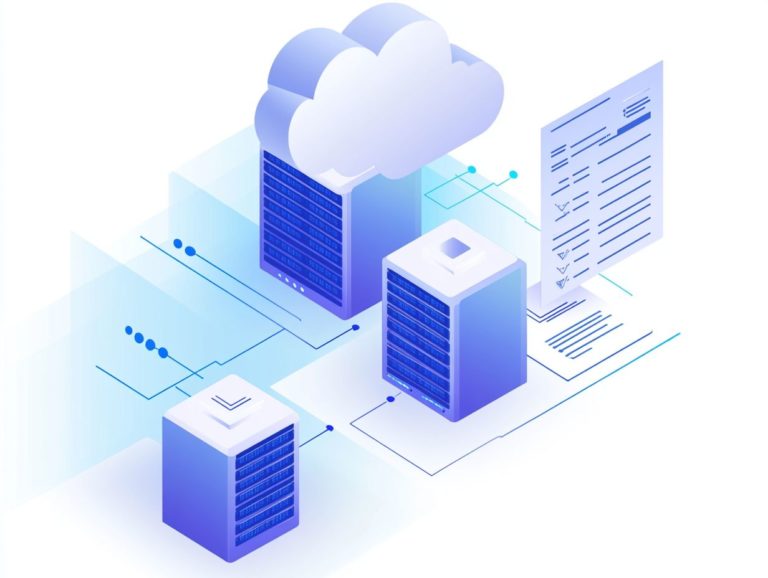Best Practices for Cloud Migration Documentation
In today’s digital landscape, cloud migration has emerged as a vital strategy for businesses eager to enhance efficiency and scalability. Without proper documentation, the process can prove complex and challenging. This guide delves into the fundamentals of cloud migration, highlighting its numerous benefits and the significance of comprehensive documentation.
You will uncover essential components to incorporate, best practices for effective communication, common challenges to anticipate, and tools that can streamline your migration journey. Jump in now to discover the keys to successful cloud migration!
Contents
- Key Takeaways:
- Understanding Cloud Migration
- Benefits of Cloud Migration Documentation
- Key Components of Cloud Migration Documentation
- Best Practices for Creating Cloud Migration Documentation
- Common Challenges and How to Overcome Them
- Tools and Resources for Cloud Migration Documentation
- Useful Software and Platforms
- Frequently Asked Questions
- What are some best practices for organizing cloud migration documentation?
- How important is version control in cloud migration documentation?
- How often should cloud migration documentation be updated?
- What should be included in a cloud migration plan document?
- How can collaboration be improved when creating cloud migration documentation?
- What is the role of documentation in post-migration maintenance and troubleshooting?
Key Takeaways:

Cloud migration documentation is crucial for a successful migration process, as it helps improve efficiency and communication. Effective documentation should include important information such as project scope, timelines, and potential risks. To overcome common challenges, consider implementing effective migration strategies for cloud adoption to address potential roadblocks and utilize useful software and platforms for documentation.
Understanding Cloud Migration
Understanding cloud migration means grasping the intricate process of transferring data, applications, and the computers and software you use to run your business from on-premises infrastructure to cloud-native services. This transition allows you to harness the myriad advantages of cloud computing, including enhanced scalability, cost efficiency, and improved performance.
In today s digital landscape, businesses must innovate and stay competitive. Effective migration strategies tailored to your unique requirements are essential for success.
What is Cloud Migration?
Cloud migration is the process of moving data, applications, and IT resources from on-premises systems to cloud providers. This transition optimizes operations and harnesses the full potential of cloud technology.
This migration can take several forms. For instance, data migration involves transferring data and databases, while application migration focuses on relocating entire software applications to a cloud environment.
Different cloud providers offer a variety of services and tools to facilitate these processes. It is essential to assess your specific needs and choose the provider that best fits those requirements.
Selecting the right cloud-native architecture is crucial. A well-designed architecture boosts performance and scalability and ensures that your system effectively takes advantage of the unique benefits offered by cloud environments.
By thoroughly understanding these elements, you can significantly enhance operational efficiency and agility, positioning your organization for success in a competitive landscape.
Benefits of Cloud Migration Documentation
The advantages of cloud migration documentation extend far beyond record-keeping. It acts as an essential asset for securing business value realization, fulfilling compliance requirements, and enabling effective risk mitigation strategies. For more insights, check out how to set goals for cloud migration throughout your transition to the cloud.
Improving Efficiency and Communication
Improving efficiency and communication during your cloud migration is crucial for a seamless transition and achieving your organizational goals. This approach fosters stakeholder collaboration and optimizes your processes.
To make this happen, consider adopting various strategies designed to streamline operations and enhance interactions among your team members. Utilizing automation tools can drastically reduce manual effort, freeing up your personnel to focus on more strategic tasks that drive value.
Set clear goals to drive your migration forward, helping everyone stay aligned and informed. Leverage monitoring tools to track progress and spot potential issues in real time.
Continuous monitoring, coupled with the analysis of performance metrics, keeps your migration on track. This vigilance enables your teams to make informed adjustments, facilitating a successful outcome.
Key Components of Cloud Migration Documentation

A thorough cloud migration documentation should encompass essential elements, such as a meticulously crafted migration plan, robust security measures, and precise infrastructure mapping, along with insights from how to develop a cloud migration strategy.
By addressing these key components, you can ensure a successful transition to the cloud environment.
Important Information to Include
When documenting your cloud migration, include key elements like rules and guidelines for managing your cloud services, application resilience strategies, and data integrity protocols. These components are vital for a secure and efficient migration process.
Effective identity and access management is critical for safeguarding sensitive information during this transition. By ensuring user permissions are accurately assigned and maintained, you significantly reduce the risks of data breaches and unauthorized access.
Compliance with regulatory standards is crucial. It helps you avoid legal penalties and boosts the overall credibility of your migration efforts. Integrating these components creates a comprehensive approach, ensuring your migration is not only streamlined but also secure and compliant with industry regulations.
Best Practices for Creating Cloud Migration Documentation
To craft effective cloud migration documentation, adhere to best practices. For guidance on this, check out how to document your migration process. Maintain a well-organized approach, ensure continuous monitoring throughout the process, and regularly update the documentation to reflect any changes in your migration plan.
Tips for Effective Documentation
For effective documentation in cloud migration, leverage optimization processes, engage in stakeholder collaboration, and refer to this comprehensive checklist to implement robust monitoring tools that track progress and performance metrics.
Think about integrating automation tools to streamline your documentation process. This reduces manual errors and frees up valuable team resources for more critical tasks.
Establish clear documentation standards to ensure everyone is aligned, enhancing communication among team members.
Thorough testing phases are essential for identifying potential issues early on, allowing you to mitigate risks before they escalate. With proper resource allocation, your team can focus on key areas while ensuring application resilience keeps systems operational and reliable, fostering a smoother transition to the cloud.
Common Challenges and How to Overcome Them
When embarking on cloud migration, you will likely face challenges that can slow your progress.
Potential roadblocks like data loss, compliance requirements, and insufficient planning are critical issues to consider. Addressing these concerns requires effective risk mitigation strategies, enabling you to navigate the process successfully and ensure a smooth transition to the cloud.
Addressing Potential Roadblocks

Addressing potential roadblocks in cloud migration demands a proactive stance on risk mitigation and a thorough understanding of data protection and network security best practices.
You may face challenges such as insufficient infrastructure, compliance issues, and resistance to change from employees. To effectively navigate these hurdles, consider leveraging cloud-native architecture, which offers scalable resources tailored to your evolving needs.
Implementing robust encryption mechanisms, which protect data by making it unreadable to unauthorized users, will ensure that sensitive data remains secure during transit and at rest. Continuous monitoring is essential for swiftly identifying anomalies or potential threats. Adhering to governance frameworks enhances security measures and builds trust among stakeholders.
By combining these strategies, you can approach the complexities of cloud migration with greater confidence.
Tools and Resources for Cloud Migration Documentation
Utilizing the right tools and resources for cloud migration documentation is essential. To effectively manage this process, consider assessment tools to evaluate cloud readiness and explore how to communicate cloud migration changes to streamline the documentation process.
This strategic approach will ensure a smoother transition and optimize your workflow.
Useful Software and Platforms
Consider utilizing a range of sophisticated software and platforms for your cloud migration documentation. To effectively manage this process, it’s helpful to follow a detailed plan like how to create a cloud migration timeline. These cloud services come equipped with features designed to track performance metrics and ensure compliance with industry standards.
These specialized solutions help you manage data migration smoothly, harnessing automation to minimize manual effort. Tools like CloudEndure and AWS Migration Hub enable you to document each phase of migration effectively, allowing you to track user activities in real-time and generate valuable insights into the process.
With powerful security features, you can feel confident that your sensitive data is safe! You can monitor user access and maintain compliance with regulatory requirements. This holistic approach mitigates risks associated with cloud transitions and enhances the overall efficiency of your migration journey.
Frequently Asked Questions
What are some best practices for organizing cloud migration documentation?
Some best practices include creating a clear naming convention for files and folders, using a centralized repository for all documentation, and categorizing documents based on their purpose (e.g., planning, implementation, post-migration).
How important is version control in cloud migration documentation?

Version control is vital as it helps track changes to documents, ensures consistency across versions, and allows for easier collaboration among team members. It helps you manage changes and ensures everyone uses the latest version.
How often should cloud migration documentation be updated?
Update your documentation regularly throughout the migration process. Perform a final review and update after migration is complete to ensure that all changes and decisions are accurately documented for future reference.
What should be included in a cloud migration plan document?
A cloud migration plan document should include a detailed timeline, budget, risk assessment, communication plan, and roles and responsibilities of team members. It should also outline specific steps and strategies for the migration process.
How can collaboration be improved when creating cloud migration documentation?
To improve collaboration, use a centralized repository, establish clear roles and responsibilities for team members, and utilize tools that allow for real-time editing and commenting.
What is the role of documentation in post-migration maintenance and troubleshooting?
Documentation is crucial for post-migration maintenance and troubleshooting. It serves as a reference for the configuration of the new cloud environment, helps identify issues, and provides a basis for resolving them, especially when following cloud migration best practices for 2024.






